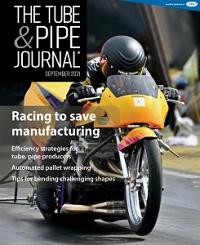Member, Strategic Advisory Board
- FMA
- The Fabricator
- FABTECH
- Canadian Metalworking
Categories
- Additive Manufacturing
- Aluminum Welding
- Arc Welding
- Assembly and Joining
- Automation and Robotics
- Bending and Forming
- Consumables
- Cutting and Weld Prep
- Electric Vehicles
- En Español
- Finishing
- Hydroforming
- Laser Cutting
- Laser Welding
- Machining
- Manufacturing Software
- Materials Handling
- Metals/Materials
- Oxyfuel Cutting
- Plasma Cutting
- Power Tools
- Punching and Other Holemaking
- Roll Forming
- Safety
- Sawing
- Shearing
- Shop Management
- Testing and Measuring
- Tube and Pipe Fabrication
- Tube and Pipe Production
- Waterjet Cutting
Industry Directory
Webcasts
Podcasts
FAB 40
Advertise
Subscribe
Account Login
Search
Everything manufacturers need to know about the employee retention credit
Tips and pointers to clear up many of the myths and misconceptions about the ERC
- By Myron Moser
- August 17, 2021
- Article
- Shop Management

The rules that govern the Employee Retention Credit have changed, and generally the new rules have expanded the number of companies that can claim it. Still, myths and misconceptions are common. Getty Images
The Employee Retention Credit (ERC) originally was introduced as part of the Coronavirus Aid, Relief, and Economic Security (CARES) Act in 2020, and since the passing of the Consolidated Appropriations Act of 2021 in December 2020, this provision has been expanded significantly to reward more business owners for keeping employees on the payroll throughout the pandemic.
The most recent update allows businesses to take advantage of this lucrative tax break for all of 2021.
Congress has allotted billions of dollars to provide tax relief to American businesses, and the ERC could potentially eliminate your payroll tax and deliver a cash refund to those who qualify. In many cases, the tax credit can be tens of thousands of dollars, and in some cases, hundreds of thousands.
Unfortunately, many manufacturers are not looking at this opportunity, or they are prematurely disqualifying themselves by reviewing outdated guidelines or failing to properly document claims for these credits.
Seven common misconceptions come up repeatedly.
I already filed a claim through the Paycheck Protection Plan (PPP) and had my loan forgiven, so I do not qualify for the ERC.
With the passage of the Consolidated Appropriations Act of 2021, Congress changed this rule, so you can now claim both PPP and ERC. Generally, first-draw PPP covers only 2.5 times the monthly payroll costs over six months, which does not cover all wages spent over the qualifying timeline. So, the ERC can help business owners maximize their benefit this year.
We did not see a drop in revenue of at least 50% during the pandemic.This is an outdated guideline. Recent legislation regarding the ERC states that a 20% revenue reduction now qualifies. Also, this is not the only way to qualify.
I did not see a drop in revenue, so I do not qualify.A drop in revenue is not the only way to qualify for the ERC. If you experienced a disruption of any kind, your business is well positioned to qualify for this credit. Common disruptions we see in filings almost daily from manufacturing facilities that have qualified for this credit include:
- Full or partial government-mandated shutdowns.
- Supply chain disruptions.
- Inability to work with vendors and access equipment.
- Decrease in working hours to sanitize facilities.
- Shift in hours of operation.
- Supply chain disruptions.
Only essential businesses qualify.It no longer matters if a business was deemed essential or nonessential to qualify for the ERC. Any of the above disruptions or shutdowns can qualify.
If my company grew during the pandemic, I do not qualify.Even companies that grew during quarantine can qualify by looking at qualified expenses, such has health plan expenses.
Our sales are back on track in 2021, so I no longer qualify.Business owners can determine eligibility based on revenue lost in 2020. In addition, shutdowns and common business disruptions can still qualify in 2021.
My company has more than 500 employees, so I don’t qualify. The ERC looks at full-time equivalent (FTE) employees who work 30 hours or more per week. So even if you have more than 500 employees, the calculation of all FTE employees you have on payroll can still be less than 500.
Any employees who were paid to not work, or worked less than the time they were paid for, can qualify businesses for this credit, and these wages would not be restricted by employee count.
If your business was not able to operate in a way that was comparable to pre-COVID times, you most likely qualify. So remember, there are two lanes to qualify: revenue and disruption. A disruption is any pandemic-related factor that forced your facility to alter its day-to-day operations in any way.
Moving Forward with the ERC
The manufacturing industry had to pivot quickly and make adjustments to maintain operations over the last year. The ERC can help manufacturers recover and grow as the pandemic and its effect recede. The credit can be used to offset or eliminate payroll tax, hire more employees, restore your supply chain, rekindle relationships with vendors, and more.
The manufacturing industry is the backbone of our country’s economy, and Congress has expanded this credit to ensure business owners are taking advantage of this opportunity to start anew and get our country back on track.
About the Author

Myron Moser
844-524-0077
About the Publication
Related Companies
subscribe now

The Tube and Pipe Journal became the first magazine dedicated to serving the metal tube and pipe industry in 1990. Today, it remains the only North American publication devoted to this industry, and it has become the most trusted source of information for tube and pipe professionals.
start your free subscription- Stay connected from anywhere

Easily access valuable industry resources now with full access to the digital edition of The Fabricator.

Easily access valuable industry resources now with full access to the digital edition of The Welder.

Easily access valuable industry resources now with full access to the digital edition of The Tube and Pipe Journal.
- Podcasting
- Podcast:
- The Fabricator Podcast
- Published:
- 04/16/2024
- Running Time:
- 63:29
In this episode of The Fabricator Podcast, Caleb Chamberlain, co-founder and CEO of OSH Cut, discusses his company’s...
- Trending Articles
Zekelman Industries to invest $120 million in Arkansas expansion

3D laser tube cutting system available in 3, 4, or 5 kW

Corrosion-inhibiting coating can be peeled off after use

Brushless copper tubing cutter adjusts to ODs up to 2-1/8 in.

HGG Profiling Equipment names area sales manager

- Industry Events
16th Annual Safety Conference
- April 30 - May 1, 2024
- Elgin,
Pipe and Tube Conference
- May 21 - 22, 2024
- Omaha, NE
World-Class Roll Forming Workshop
- June 5 - 6, 2024
- Louisville, KY
Advanced Laser Application Workshop
- June 25 - 27, 2024
- Novi, MI


























